
Case Report
Austin J Forensic Sci Criminol. 2015;2(1): 1014.
A Fatal Perforating Lawn Mower Injury
Butch Huston*
Ramsey County Medical Examiner’s Office
*Corresponding author: Huston B, Ramsey County Medical Examiner’s Office, 300 East University Ave., St. Paul, Minnesota, USA
Received: February 10, 2015; Accepted: March 22, 2015; Published: March 30, 2015
Abstract
Penetrating and perforating projectiles resulting from lawn mowers can result in significant morbidity and lethal injuries. Most often these injuries are sustained by bystanders and not the operators of the lawn mower. This case report involves the death of a push type lawn mower operator who was struck in the chest by a fragment of wire.
Case Presentation
A 48 year old female was found lying in a prone position unresponsive on the ground outside her residence by her husband. Emergency personnel responded but did not provide any significant resuscitation as livor mortis and rigor mortis were already present. The decedent was fully dressed with one shoe on and the other shoe located approximately 10 feet away. An initial examination of the body revealed a small penetrating injury to the mid chest with a perforation of the overlying bra and shirt (Figure 1, 2). Only a small amount of blood was present on the clothing.
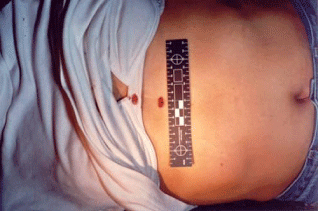
Figure 1: The decedent at the time of the scene investigation with a
perforating injury to the upper abdomen/lower chest just below the level of
the bra which is slightly raised. A corresponding spot of dried blood is noted
on the bra.
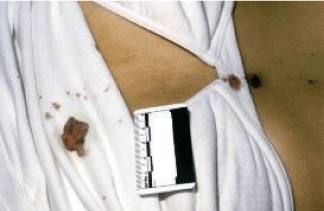
Figure 2: The decedent at the time of the autopsy with a perforating injury
to the upper abdomen/lower chest just below the level of the bra which is
slightly raised. A corresponding spot of dried blood is noted on the bra and
raised shirt.
On the other side of the residence, approximately 150 feet from the decedent, near the house and a chain link fence was a lawn mower (Figure 3). A gutter downspout was located approximately 30 feet from the house and lawn mower. The chain link fence was located two feet in front of the mower and held in place with a metal fence posts. The two feet from the mower to the fence slopes downward at an approximate 15-20° angle. On the ground near the rear trail shield was a bent portion of metal wire, consistent with the wire of the chain link fence.
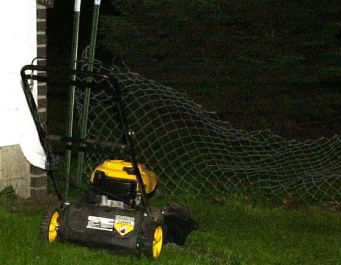
Figure 3: Around the side of the house was a lawn mower located next to a
chain link fence and in front of a 15-20° decline of the ground.
A postmortem x-ray was obtained while the decedent was still clothed and revealed multiple opaque objects including keys, bra underwire, EKG pads and a small linear radiopaque fragment of wire (Figure 4). This small linear metal object, consistent with a fragment of wire, was located within the material of the left bra cup (Figure 5). Adjacent to the piece of wire was a small exit wound on the skin along the left lateral upper chest.

Figure 4: An x-ray of the decedent prior to undressing reveals a thin fragment
of projectile wire (blue arrow), an EKG pad snap (orange arrow) and a set
of keys located in the decedent’s jacket pocket (green arrow) overlying the
underwire of the decedent’s bra.
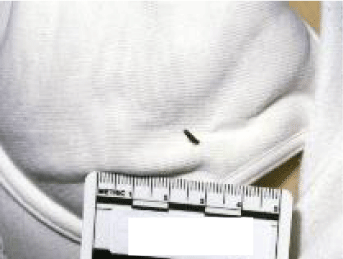
Figure 5: A small fragment of wire was located in the material of the left bra
cup.
The wire fragment was compared to the portion of wire located adjacent to the lawn mower and was consistent in diameter and color.
Internal examination revealed a perforation of the upper abdomen just 1.5 cm inferior to the manubrium of the sternum. The wound tract continued perforating the right ventricle of the heart, the septum and exiting the heart through the left ventricle (Figure 6). The wound continued perforating the left lung tissue and exited the left lateral chest wall. There was approximately 300 cc of liquid blood present within the pericardial space and 100 cc of blood present in the left pleural space.

Figure 6: The heart is shown with “A” representing the entrance wound and
“B” marking the exit wound of the wire projectile. The arrow indicates the
direction of the wound path through the heart.
The lawn mower, a Yard Man® Model 430 Push Mower, (Figures 7, 8) was inspected and appeared to be in good working condition with no gaps around the discharge door or rear trail shield. The mulcher door was up with an attached discharge guard which was securely in place. There were no modifications made to the safety equipment. Several nicks were noted to the blade, some of which appeared to be recent with exposed shiny metal.

Figure 7: Examination of the lawn mower revealed the mower to be in good
working condition with no safety modifications noted. The mulcher door was
up with an attached discharge guard which appeared securely in place.
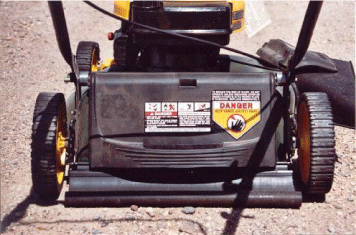
Figure 8: The discharge door of the mower appears securely in place with no
gaps or defects and the trail guard is in good condition.
Discussion
There are approximately 78,000 lawn mower injuries treated in the United States every year [1]. Lawn mower injuries most often result from direct contact with the blades or from burn injury when hot parts of the mower are touched. Projectile injuries from objects such as rock, wire or glass account for approximately 17% of all lawn mower injuries [1, 2]. Most often these injuries are sustained by bystanders and not the operators of the lawn mower as in this case [3].
The rotary blades on a lawn mower can operate at speeds up to 3,000 rpm’s resulting in projectile speeds of 232 miles per hour [1, 2, 4]. Projectiles at this speed can result in significant injury to the body and may be treated similarly to gunshot wounds. Small projectiles as in this case can result in small entrance and exit wounds. Radiographs should be obtained, prior to undressing when possible, and the clothing should be carefully inspected for defects. In nonfatal cases, these wounds may not immediately present for medical treatment until the wound becomes infected [5].
From the autopsy, the scene investigation and examination of the lawn mower, it is proposed that the slope of the ground and possibly lifting the back end of the mower resulted in a portion of the chain link wire to be discharged under the mower trail guard to perforate the decedent. The projectile wire may have been stopped by the bone of the manubrium or sternum had the injury occurred 1.5 cm superior on the body. Despite advances in safety equipment, lawn mowers can still result in fatal injuries to operators.
References
- Lau ST, Lee YH, Hess DJ, Brisseau GF, Keleher GE, Caty MG. Lawnmower injuries in children: A 10-year experience. Pediatr Surg Int. 2006; 22: 209-214.
- Mullins J. Lawn mower injuries: A review. J Emerg Nurs. 2010; 36: 83-84.
- Vollman D, Smith GA. Epidemiology of lawn-mower-related injuries to children in the United States, 1990-2004. Pediatrics. 2006; 118: e273-278.
- Park WH, DeMuth WE Jr. Wounding capacity of rotary lawn mowers. J Trauma. 1975; 15: 36-38.
- McNamara WF, Yamout SZ, Escobar MA, Glick PL. Lawn mower-related projectile injury. Pediatr Surg Int. 2009; 25: 643-645.